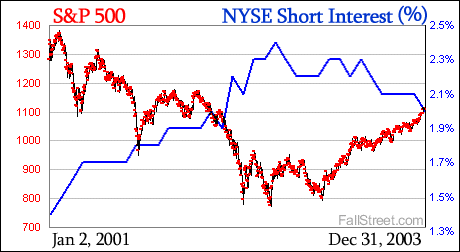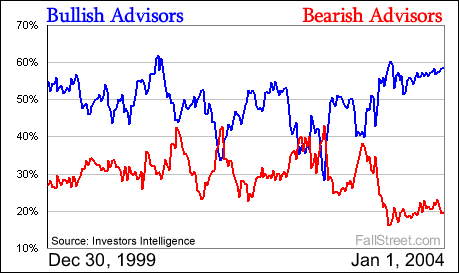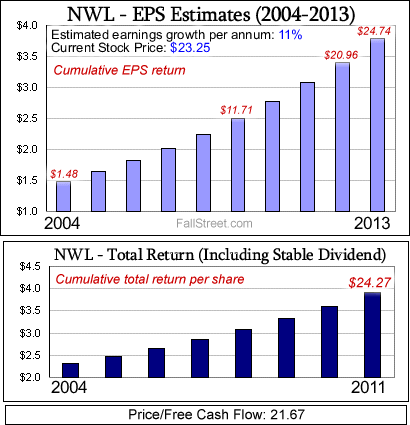January 8, 2004
Preview 2004: Investors’ Good Times Risk Rolling Right off a Cliff
By Brady Willett & Todd Alway
Two roads diverged in a yellow wood
And sorry I could not travel both
And be one traveler, long I stood
And looked down one as far as I could
To where it bent in the undergrowth….
While not traditionally regarded as analogous to the investor’s plight, Mr. Frost’s take on roads less traveled is nonetheless worthy of contemplation to begin the new-year. To be sure, today the investor is faced with two very different looking paths; one is lit up like Las Vegas with a flamboyant façade trumpeting the promise of easy money. The alternative path is austere, almost Spartan, offering at best caution, reticence, and restraint.
Needless to say, the path promising easy riches in 2004 leads straight down Wall Street. Following a 3-year bear market stocks rallied strongly last year, and the consensus is that the rally will be sustained this year. That this bullish ‘consensus’ is being supported by some of the ‘usual suspects’ of the late 1990s mania market is not in question. Rather, after three years of getting it wrong the Kudlow’s and Cohen’s got it right last year, and their unrelenting optimism is proving to be contagious leading into 2004.
Quite frankly, 2003 proved that the markets can run higher on any minor tidbit of good news regardless of how costly such news might actually be to a genuine economic recovery. With the example of President Bush’s tax package in mind – a package that was expected to bring with it job creation in 2003 but did not – or even the recorded jump in Gross Domestic Product – fuelled by heavy government spending and record consumer debt - the longer term threats to the U.S. economy have been ignored by market participants for the moment.
Bearing in mind the caveat that what constitutes ‘good news’ is largely a matter of perspective, an array of information can be cultivated to back the bullish argument. For example, equity mutual funds are collecting new money at a strong clip (an estimated $138.1 billion in new money in 2003as of November) and this trend is unlikely to immediately change given that bond/money markets are unattractive by comparison. Furthermore, investor confidence is higher now than it was during the mania days, and short selling interest (although coming down in 2003) remains at levels significantly higher than during the mania days. Accordingly, with more monetary stimulus in the pipe, and the Fed – seemingly on a daily basis – promising to keep interest rates low for a ‘considerable period’ of time, the near term outlook for stocks is bullish.
 |
 |
Added to the basic bullish case is a series of historical precedents – stocks tend not to ‘fight the Fed’, a cyclical recovery does not become exhausted until inventories are replenished, and stocks usually do well in an election year. Unfortunately for the Bullish case, isolated historical correlations can hardly be an absolute gauge of future stock market performance. We can trawl the historical record for equally compelling correlations which suggest that the near term picture for the markets is rather bleak. For example, according to Thomson Financial the value of insider sales has exceeded purchases by at least a 20-to-1 margin for the past eight months (on 11 of the 16 times that happened the stock market declined six months later). Moreover, longer term historical concerns such as escalating government deficits (which, in the case of the U.S., is nearing 5% of GDP), record low consumer savings rate, and trailing P/E multiples above 20, suggest that a stock market setback looms.
Suffice it to say, and to paraphrase Warren Buffet, a study of the historical record has yet to generate many wealthy librarians. Rather, some of the most successful investors of all-time – Warren Buffett included – are not electing to buy into election year rallies and/or taking the path of least resistance into stocks today because the expected return on invested capital is unattractive*. Perhaps the only assurance when it comes to the stock markets (as is the case for most institutions) is that the present is continually being written rather than recalled from history.
* Exposing the Illusion of Expectations
A simple case of overvaluation today is Yahoo – one of the premier online companies. Yahoo currently trades at 141 times historical earnings, and 88 times consensus 2004 earnings estimates. Thus, and not taking into account accounting chicanery, for every $1 that investors pay for Yahoo today a 1.13 cent return (if consensus earnings estimates are to be trusted) will be made in 2004. You don’t need to be the Oracle of Omaha to conclude that a 1.13 cent return for every dollar invested is rather anemic (lowly money market funds can match this return). Nevertheless, in the case of Yahoo it is the long-term horizon which supposedly offers riches.
 |
If you buy and hold Yahoo today under the belief that earnings will rise by 37.5% a year forever (the consensus 5-year growth target), you will make back your investment from earnings by year number 12. Moreover, if the future arrives as expected, buying Yahoo today could mean that by year 16 you will be receiving a 1-1 return on your original investment. In other words, Yahoo is trading at a 1 times 2019 earnings estimates (given that Wall Street has gone from treating trailing P/E multiples as the gospel to almost exclusively focusing on forward P/E multiples we have to wonder just how far fetched the 1 times 2019 EPS joke is).
Suffice it to say, and also taking into account Yahoo’s 101 times free cash flow valuation, no investor actually believes that Yahoo is a good investment in 2004 (investing is all about returns, not speculating about stock prices). Rather, even under the best circumstances the actual return from Yahoo’s business will be miniscule.
Nevertheless, the bullish case for Yahoo does not focus on business returns, but on stock price returns (a different animal altogether). Why any individual is buying Yahoo today can be summed up with 3 speculations:
1) Some Yahoo shareholders are looking to unload their stock at a higher price – since stocks are rising and could continues to rise, Yahoo will rally if more money comes into the markets. Yahoo may also rise if it earns 1.5 cents per dollar in 2004 instead of 1.13 cents (any good news sends stock prices higher!)
2) Some investors -- the statistics suggest most (over 90 million Americans own mutual funds) -- are making no specific decision to own Yahoo, but simply allowing their mutual fund, hedge fund, or pension fund manager to make their investments for them.
3) Some Yahoo shareholders are willing to hold for many, many, many years (or until the return on capital becomes more attractive). These types of investors are prepared to make 1.13 cents on the dollar in 2004 because they do not believe that what happens in the short term is relevant.
That fund managers, with historically low cash holdings and a penchant for trying to produce quarter to quarter momentum gains, are trading in and out of Yahoo stock is certain - Yahoo’s entire float trades hands roughly every 60-days. Moreover, that many individual investors are purchasing Yahoo on the speculation that the company will beat forecasts is probably also a certainty. However, exactly how many YHOO shareholders have made the rational decision to purchase the company based upon the anticipated long-term returns from the business is unknown. We would speculate that no one is buying YHOO the business for the long-term, at least not anyone that is rational. After all, if you throw a dart at the markets you are likely to hit a better return vehicle than YHOO. A simple example is Newell Rubbermaid, a company covered in this year’s Wish List report.
 |
Choose wisely
The investor wants more capital returned to them at some point in the future than the capital they invest today. Exactly how and why more capital will be returned is what the investor needs to contemplate.
The trite clichés that serve to obfuscate how actual business returns are generated are all too apparent today. These include, but are not limited to, stocks typically do well in an election year; since the Fed is going to hold rates low stocks will rise; and since bonds are unattractive stocks are very attractive. These shibboleths focus on the price investors may be willing to pay for each share, not on the value that each share possesses.
Investors like Warren Buffett and Benjamin Graham never looked for stock market returns, but return on invested capital. Other things being equal, if a company is able to generate above average returns eventually this will translate into a higher stock price. And while companies like Coke, Wal-Mart, and Yahoo today can be expected to generate solid returns in the future, we continue to fear that these expected returns are already priced into the stock.
Conclusions
Following the popular path can sometimes prove perilous. Such was the case during the late 1990s when a herd of investors piled into skyrocketing U.S. stocks just in time for a vicious 3-year bear market. Whether or not following the herd into U.S. stocks today will prove perilous in 2004 is a difficult contemplation. In 1996 Greenspan uttered ‘irrational exuberance’ yet it took until early 2000 for the markets to peak: claiming that investors are acting irrationally today does not immediately foretell of a crash tomorrow or the next day…
Regardless, it is undoubtedly true that the path away from stocks – into cash that is not of the U.S. variety, gold/silver, and inflation protected securities – is shrouded in ambiguity. Given its quick rise in the last year gold may be poised for a mammoth sell-off sometime in 2004. Nevertheless, the fact is that much of the ‘good news’ that serves to support stocks should also support gold. To be sure, with the Fed promising to debase the dollar – seemingly on a daily basis – by waiting to raise interest rates, some would argue that gold’s glitter is much brighter than that of stocks. After all, how much did U.S. stocks rally last year when translated in Euro’s, loonies, or Aussie dollars?
In short, we believe that U.S. stocks offer few value investments, U.S. bonds are potentially reversing a 20+-year bull run in the near term, the U.S. dollar is overvalued, gold/silver are undervalued, deflationary forces will ultimately return 1-5 years from now, and the U.S. consumer needs to become more financially grounded before any lasting recovery can occur.
We do not offer any guaranteed foresight into the market’s direction in 2004 – we, like most, envision a momentum driven marketplace with potential upside in the first half of 2004 and a vicious sell off in the latter half of the year. Nevertheless, the spectacular stock market gains in 2003 did little to change our investment approach; elections, fund flows, confidence levels, and stimulus packages will never make us change our course.
As for Frost’s memorable poem, ‘The Road Less Traveled’, he ends it with a lesson no investor should forget.
Two roads diverged in a wood
And I took the one less traveled by
And that has made all the difference.
Leading into 2003 those investors that were weary about bubbly U.S. stocks prices made convincing arguments that ultimately proved to be wrong. The lesson for steadfast bears is that shorting stocks can be dangerous – that anything can happen inside of a 1-year time frame. The argument to be made leading into 2004 is that monetary, fiscal, and investor stimulus plans (yes, ‘stocks never decline for 4-years in a row’ proved prescient) have finally caught traction. Valuation and quality of earnings concerns be damned, the good times are here.
“Give me a trillion dollars, and I can show you a good time, also.”
Warren Buffett, on the U.S. economy's response to government spending and tax cuts.
BWillett@fallstreet.com TAlway@fallstreet.com
a